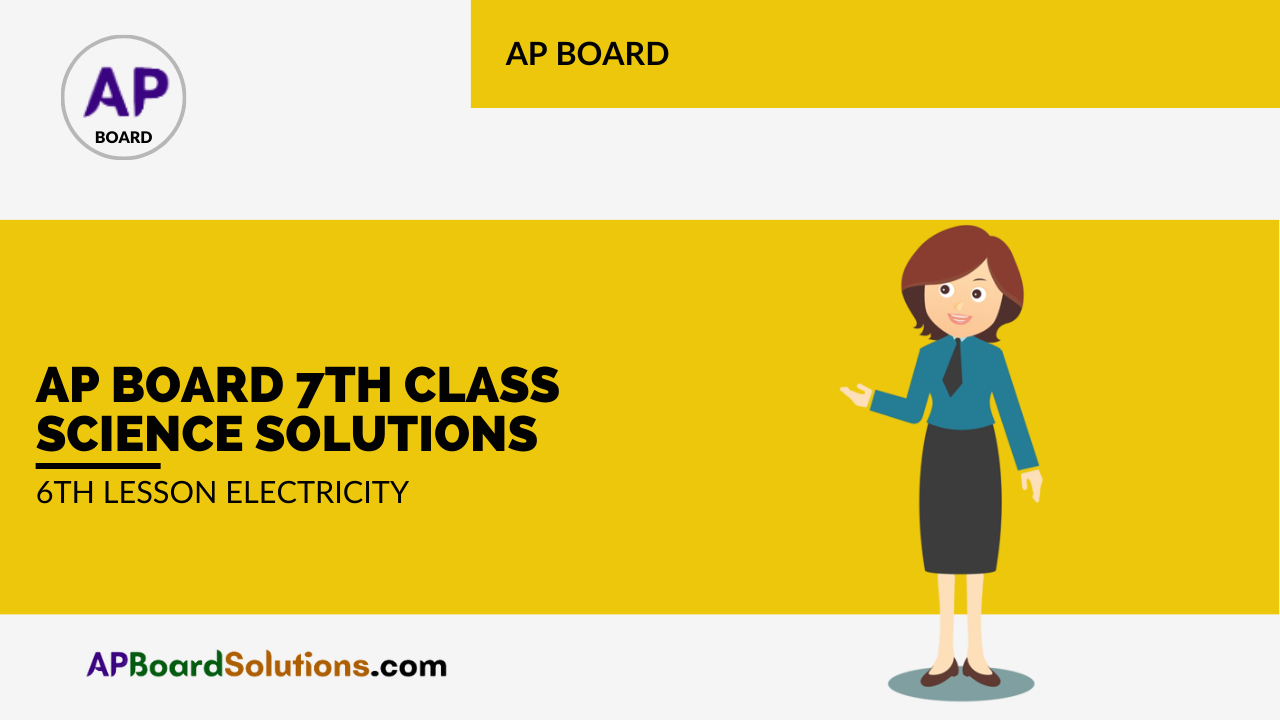SCERT AP 7th Class Science Study Material Pdf 6th Lesson Electricity Textbook Questions and Answers.
AP State Syllabus 7th Class Science 6th Lesson Questions and Answers Electricity
7th Class Science 6th Lesson Electricity Textbook Questions and Answers
Improve Your Learning
I. Fill in the blanks.
1. Longer line in the symbol for a cell represents its ____ terminal and the shorter line represents ____ terminal.
2. Iron box works based on ____ effect of electric current.
3. The symbol for open switch is _______ .
4. The combination of two or more cells is called a ____
5. Expand MCB ____
Answer:
1. Positive, Negative
2. heat
3. ![]()
4. battery
5. Miniature Circuit Breaker
II. Choose the correct answer.
1. When cells are connected in series, it has
a) Single loop connection
b) Two loops
c) Many loops
d) None
Answer:
a) Single loop connection
2. Four bulbs are connected in parallel. When one bulb is removed then the remaining bulbs are
a) Put off
b) Continuously glowing
c) Blinking
d) None
Answer:
b) Continuously glowing
3. Statement 1: Generation of heat due to electric current is known Magnetic effect of electricity.
Statement 2 : An electromagnet works on magnetic effect of Electricity.
a) Both statements are true.
b) Both statements are false.
c) Statement 1 is true, Statement 2 is false.
d) Statement 1 is false, Statement 2 is true.
Answer:
d) Statement 1 is false, Statement 2 is true.
![]()
4. Ramu’s house has five 60W bulbs. If they used all the bulbs for 5 hours. Then the power consumed by him

a) 1500 KWH
b) 0.3 KWH
c) 70 KWH
d) 1.5 KWH
Answer:
d) 1.5 KWH
5. Which of the following works on the basis of heating effect of electric current?
a) Electric Crane
b) Electric Lift
c) Escalator
d) Hair drier
Answer:
d) Hair drier
III.Matching
| A) MCB | 1. Safety device used in electric current |
| B) Fuse | 2. Two or more cells joined together |
| C) Battery | 3. Compact Fluorescent Lamp |
| D) Cell k | 4. Miniature Circuit Breaker |
| E) CFL | 5. Converts chemical energy into electrical energy |
| 6. Useful for opening and closing circuit |
Answer:
| A) MCB | 4. Miniature Circuit Breaker |
| B) Fuse | 1. Safety device used in electric current |
| C) Battery | 2. Two or more cells joined together |
| D) Cell k | 5. Converts chemical energy into electrical energy |
| E) CFL | 3. Compact Fluorescent Lamp |
IV. Answer the following questions.
Question 1.
Why are bulbs in series put off when a bulb is removed from it?
Answer:
- In series connection electricity has only one path.
- If a bulb is removed from the series connection of bulbs, the circuit becomes open.
- So, remaining bulbs are put off as the circuit open.
Question 2.
Read the following riddles and answer them.
1. I am used to close-or open the circuit. Who am I?
2. I will give you light. Who am I?
3. I convert chemical energy into electrical energy. Who am I?
4. Without me you cannot connect the electrical components. Who am I?
Answer:
- Switch
- Bulb
- Cell
- Connecting wires
Question 3.
Give examples for electric appliances which work on the property of heat effect of electricity.
Answer:
Examples for electric appliances which work on the property of heat effect of electricity:
- Electric heater
- Electric iron box
- Soldering gun
- Electric kettle
- Electric rice cooker
![]()
Question 4.
A cell, 5 bulbs and a switch are connected in a circuit but bulbs are not glowing. Write the possible reasons for this.
Answer:
Possible reasons:
- May be connected a dysfunctional or less voltage cell.
- May be switch in off position.
- Wires may be cut any where or not properly connected.
- At least one of the bulbs may be damaged (If they are connected in series).
- All the bulbs may be damaged. (If they are connected in parallel)
Question 5.
Describe the process to prepare an electromagnet.
Answer:
1) Take an iron nail.
2) Wound the insulated copper wire tightly around the nail.
3) Connect the two ends of the coiled copper wire to a battery and a switch in series connection.
4) 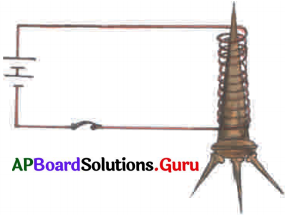
5) Place some pins near the iron nail.
6) Now switch on the circuit.
7) Observe that all pins cling to the end of the iron nail.
8) This indicates coiled copper wire around nail acts as magnet when electricity passes through it.
9) It means the coiled copper wire around the nail acts as an electromagnet.
10) Now switch off the circuit.
11) Observe that all pins fall from the iron nail.
12) Hence, we can say that the coiled copper wire does not act as a magnet when no electricity passes through the circuit.
Question 6.
Draw the symbols for the following.
A) Bulb
B) Cell
C) Battery
D) Open Switch
Answer:
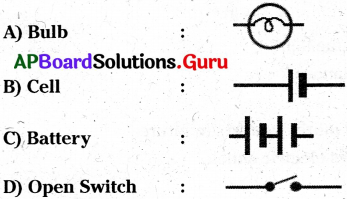
Question 7.
Draw a circuit diagram of electrical components in a sequence by using cell, bulb, switch is off mode and connecting wires.
Answer:

Question 8.
How do you appreciate the role of magnetic effect and heating effect in our daily life?
Answer:
- The production of heat due to the flow of electricity through a wire is called heating effect of electricity.
- We are using many home appliances like electric iron boxes, electric cookers, electric heaters, geysers, hair dryers which work on the principle of heating effects of electricity.
- The above said home appliances contain heating elements which produce heat.
- The production of magnetic force due to the flow of electricity through a wire is called magnetic effect of electricity.
- Loud speakers, MRI machines, generators, metal detectors, mobile phones, mixer grinders, electric fans, electric bells, electric motors etc.; work based on the magnetic effect of electricity.
- In this, way, heating and magnetic, effects of electricity are used in medical, automobile, industrial, agricultural etc., fields and also in homes.
- The devices and home appliances have made our lives more comfortable.
- Hence, I appreciate the role of magnetic effect and heating effect^ in our daily life.
Question 9.
Prepare some slogans to create awareness on wastage of electricity.
Answer:
- Save electricity – Save money.
- Turn off the lights, before leaving.
- Today’s wastage is tomorrow’s shortage.
- The less you burn, the more you earn.
- Save power – Save nation.
- Be polite – turn off the light.
- When the sun is bright – say no to tube light.
- Energy is precious – use 5 star appliances.
- Leave filament bulbs – Use LED’S
- Less consumption of power – Leads more comforts in future.
Question 10.
Suggest first aid when a person suffers electric shock.
Answer:
First aid for electric shock :
- If the shock is severe and the person is unconscious, give mouth to mouth artificial respiration.
- Sometimes heart beat ceases, at that time keep your palms on his chest and press down and release until the heart beat is recovered. This is called Cardio Pulmonary Resuscitation (CPR).
- Immediately take him to the hospital.
7th Class Science 6th Lesson Electricity InText Questions and Answers
7th Class Science Textbook Page No. 83
Observe the picture carefully.
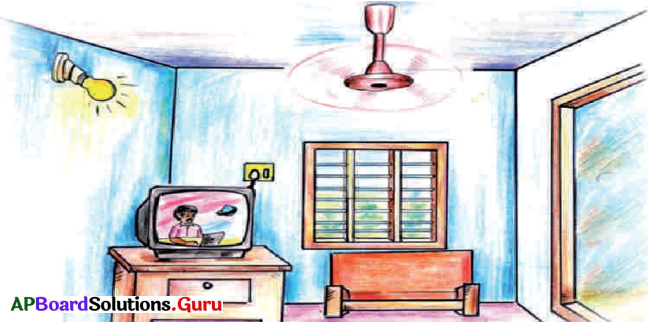
Question 1.
What are the electric devices you find in the above picture?
Answer:
1) Bulb 2) Fan 3) TV.
Question 2.
List out the electric devices used in your homes.
Answer:
1) TV 2) Fans 3) CFL bulbs 4) LED bulbs 5) Tube light (LED) 6) Music system 7) Chargers 8) Refrigerator 9) Electric geyser 10) Vapourizer 11) Iron box 12) Calling bell 13) Mixie 14) Wet grinder 15) AC 16) Motor pump 17) Mosquito repellent.
7th Class Science Textbook Page No. 84
Question 3.
Why does a bulb glow when we switch it ON?
Answer:
When we switched ON the bulb electricity flows through the wire and makes the bulb to glow.
Question 4.
What do you observe inside the cell?
Answer:
- Carbon rod with a metal cap.
- Carbon powder.
- Ammonium chloride paste.
Question 5.
Can we make a cell of our own?
Answer:
Yes, we can make a cell by using a zinc plate, copper plate, a small bulb, connecting wires, lemon or orange, crocodile clips.
7th Class Science Textbook Page No. 85

Question 6.
Do you know the type of cell is used in wrist watch?
Answer:
Button cells are used is wrist watches.
Question 7.
How many types of electric cells shown above are known to you?
Answer:
I know the dry cells, lithium cells, button cells and alkaline cells.
Question 8.
Where do we used dry cells?
Answer:
In our daily life we use dry cells in torch lights, wall clocks, radios etc.
7th Class Science Textbook Page No. 86
Question 9.
Does a bulb glow when switch is in off position? Why?
Answer:
When the switch is in off position, bulb does not glow. Because the circuit is opened.
7th Class Science Textbook Page No. 87
Question 10.
Among all these bulbs which bulb consumes less electricity?
Answer:
- We can observe star symbols (power saving star rating) are marked on electrical appliances.
- The number of stars on them indicates the energy efficiency of that device.
- The electrical appliance with more stars consumes less electricity.
- LED bulbs are more energy savers than other bulbs.
![]()
Question 11.
Is there any protection provided for electric devices in our house?
Answer:
Yes. The fuse is used to protect the electric devices in our house.
Question 12.
If there is a power failure only in your house. What do you check first?
Answer:
We will check the fuse first.
Question 13.
Have you seen the electric device shown in the figure. Where is it used?
Answer:
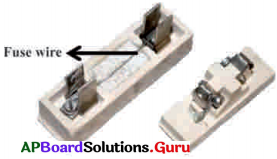
- The electrical devices shown in the figure are fuses.
- Fuses are used at meter board to protect the devices from excess flow of electricity.
Question 14.
Is there any other safety device which can be used as a fuse?
Answer:
Yes, MCB can be used as a fuse.
7th Class Science Textbook Page No. 88

Question 15.
Have you ever seen this component?
Answer:
Yes, I saw it. It is a MCB.
Question 16.
Which is a better safety device, electric fuse or MCB?
Answer:
MCB is better, when compared to electric fuse. There is no need to change it often. But wire in electric fuse has to be changed whenever it melts.
Question 17.
Do you know how to show the connections of the electric components in a circuit?
Answer:
Yes. We can show the connections of the electric components in a circuit by its symbols.
Question 18.
What electric components do you find in the figure?
Answer:

1) Switch 2) Bulb 3) Wire 4) Battery.
Question 19.
Is it possible to draw realistic electric components every time? Why?
Answer:
- Drawing circuit diagrams with realistic components is difficult.
- If the circuit is a bigger one with several components it is much more difficult.
- To overcome this, standardized symbols of electric components are used to draw the circuit diagrams.
7th Class Science Textbook Page No. 89
Question 20.
Isn’t it so easy to draw like this?
Answer:
It is easy to draw a circuit by using symbols of electric components than realistic components. .
Question 21.
What difference do you find between circuit diagrams A and B?

Answer:
- We observe that the bulb in circuit ‘A’ is not glowing and in circuit ‘B’ it is glowing.
- We can also see the switch is in OFF mode in circuit diagram A and it is in ON mode in circuit diagram B.
- Circuit diagram ‘A’ represents open circuit, where as circuit diagram ’B’ represents closed circuit.
7th Class Science Textbook Page No. 90
Question 22.
Is it possible to connect more than one bulb or one cell in an electric circuit?
Answer:
Yes, it is possible.
Question 23.
What happens if we connect more bulbs or cells in an electric circuit?
Answer:
- There are two ways to connect more bulbs or cells in an electric circuit they are parallel and series connections.
- In parallel connection electricity has more than one path where as in series connection only one path.
- If the number of cells are connected in series the brightness of the bulbs enhanced where as in series the brightness of bulb remains same.
Question 24.
Have you observed a large number of bulbs used in decorations of marriage functions, festivals etc.?
Answer:
- Yes, I have observed a large number of bulbs used in decorations of marriage functions, festivals etc.
- All the bulbs are connected one after one that means in series.
![]()
Question 25.
What happens when we connect two cells and two bulbs in the same path?
Answer:
- If we connect two cells and two bulbs in the same path, it is called series connection.
- The brightness of the bulbs increased.
7th Class Science Textbook Page No. 92
Question 26.
Where can we observe these type of connections? (Series & Parallel)
Answer:
- We can use series connection of cells in torch light, toys, remotes, wall clocks,radio etc.
- We can use parallel connection of cells for a long – lasting battery life.
Question 27.
Do you know how several electric devices are connected in your home? Did you observe any pattern in their connections?
Answer:
If All the electric devices in our house are connected in parallel.
7th Class Science Textbook Page No. 93
Question 28.
Where can we observe these types of connection?
Answer:
We use series connection of bulbs for decoration purpose, parallel connection of bulbs in house hold connections.
7th Class Science Textbook Page No. 94
Question 29.
Naime the electrical devices used to produce heat?
Answer:
Electric iron box, electric heater, geyser, grills, electric cooker etc. are the electrical devices used to produced heat.
Question 30.
Have you ever used an iron box to iron your clothes? How does it produce heat?
Answer:
- Electric iron box contains the coil of wire (filament) which produce heat, when electricity passed through it.
- It is called heating effect of electricity.
![]()
Question 31.
Which electric appliances work on the principle of heating effect of electricity?
Answer:
1) Electric stove, 2) Electric room heater, 3) Electric iron box, 4) Electric kettle, 5) Electric cooker, 6) Water heater, 7) Geyser, 8) Hair dryer, etc. are working on the principle of heating effect of electricity.
7th Class Science Textbook Page No. 95
Question 32.
1) How does a fan work?
2) What makes the fan to rotate?
3) What is the principle involved in it?
Answer:
- Fan works on the principle of magnetic effect of electricity.
- The magnetic force, which is produced due to the flow of electricity through a wire (coil) makes the fah to rotate.
- The principle, magnetic effect of electricity is involved in it.
7th Class Science Textbook Page No. 96
Question 33.
Which electric appliances work on the principle of magnetic effect of electricity?
Answer:
1) Electric fan, 2) Electric bell, 3) Electric motor, 4) Loud speaker, 5) MRI machines, 6) Generators, 7) Metal detectors, 8) Mobile phones, 9) Mixer grinders, etc. work on the principle of magnetic effect of electricity.
Question 34.
Have you seen the electric meter in your house? What do you find in the meter?
Answer:
I find reading of consumed electricity in units.
Question 35.
What does the term ‘one unit’ mean?
Answer:
1 unit = 1000 watt = 1 K.W.H.
Question 36.
How is the usage of electricity measured?
Answer:
Usage of electricity is measured in KWH (unit).
7th Class Science Textbook Page No. 98
Question 37.
What is an electric shock and when does it occur?
Answer:
- An electric shock occurs when a person comes into contact with an electrical source.
- Electricity flows through a portion of the body causing a shock.
Think & Respond
7th Class Science Textbook Page No. 85
Question 1.
Now a days we are using rechargeable torchlights, bulbs, mobile phones and fens. Think and discuss with your classmates about the working of these electric devices and the cells used in diem.
Answer:
- A cell is made up of three parts, a cathode, an anode and an electrolyte (a chemical).
- A cell works by connecting its stored chemical energy, into electrical power
- One the electrolyte of the cell is used up it doesn’t work further in non – rechargeable cells (Alkaline cells).
- Electrons (negative charges) travel from an anode to a cathode until the anode is considered empty or dead.
- A rechargeable cell, a charger can reverse the electron flow again to restore at the anode. This is called charging.
- This reversing process depends upon the electrolyte used in the cell.
- Normal cells do not contain such type of electrolytes to reverse the charge.
- But, the cells like NiMH (Nickel – Metal Hydride), Lithium – ion are capable of reversing the charge when charged it for number of times.
- This type of rechargeable batteries are used in rechargeable torch lights, bulbs, mobile phones and fans.
7th Class Science Textbook Page No. 92
Question 2.
a) What happens if more cells are connected in a series?
b) Is there any restriction on the number of cells in a circuit for a given bulb?
Answer:
a) If more cells are connected in a series, voltage increases in the circuit. That means the strength of the current in the circuit increases.
b) When we will join lot of cells in a circuit, then the bulb will not be able to handle the large amount of energy supplied to it. Hence, the bulb may damage.
7th Class Science Textbook Page No. 95
Question 3.
Do all home appliances produce heat when electricity passes through them?
Answer:
- Yes, all home appliances produce heat when electricity passes through them.
- But the amount of heat produced depends on the material of conductor, such as length, thickness and nature of it.
7th Class Science Textbook Page No. 96
Question 4.
Is it possible to create permanent magnets using the magnetic property of electric current? Think and discuss with your classmates and make notes on this.
Answer:
- Electromagnets are not permanent magnets because they lose the property of magnetism when the circuit is open.
- A permanent magnet has a magnetic field all the time unless it is heated.
- But electromagnet doesn’t retain its magnetism all the time, without current.
![]()
7th Class Science Textbook Page No. 98
Question 6.
Why don’t we use wet stick to push away a person when he get electric shock? Think and discuss with your friends.
Answer:
- Wet stick contains some amount of water throughout it.
- Water is a good conductor of electricity (ofcourse, pure water does not pass current).
- If we touch the person to push away from the electric wire, the current passes through the water into our body.
- It causes to get electric shock to us also.
- So, we should not use wet stick to push away a person when he get electric shock.
- We should use dry stick only to do that.
Activities and Projects
Question 1.
Collect any manual of electric equipment. Read the information in detail and answer the following questions.
A) When was it manufactured and how long can we use it?
B) How many stars are given to it?
C) Is it working on the basis of magnetic or heating effect?
Answer:
I Read the manual of a washing machine.
A) It was manufactured on 8<sup>th</sup> March 2020.
B) It was given 5 stars.
C) It is working on the bases of both magnetic effect (motor) and heating effect (in built heater).
Question 2.
Find out the electric meter readings for 3 months in your house. Record your observations. Ask your teacher about how electricity bill is paid.
Answer:

Question 3.
Make a pamphlet on “Save electricity, don’t waste it”. Display it on the wall magazine?
Answer:
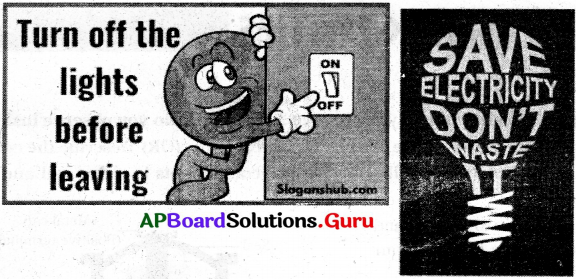
Question 4.
Collect last month’s electricity bills from your friends or neighbours houses and record the data. Advise them to change their ordinary bulbs with CFL bulbs. Again collect the electricity bilis of next month and observe the differences between the two bills. Discuss your observations with your friends and suggest better bulb.
Answer:
Observation sheet (Student Activity).
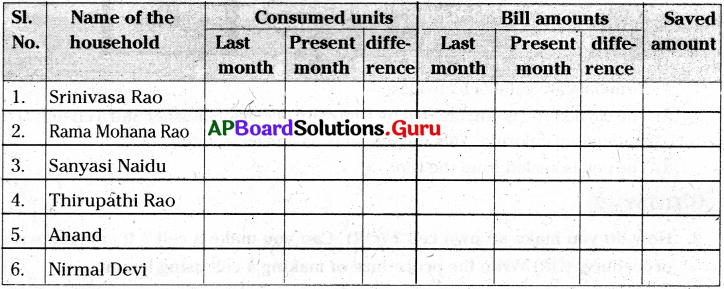
Conclusion :
After replacing ordinary bulbs with CFL/LED bulbs the consumption of electricity is reduced and Bill amount is saved.
Question 5.
If anyone around you has suffered an electric shock, collect the information along with their feelings and know about CPR. Record your observations in your note book and discuss with your friends.
Answer:
Observation sheet (Student Activity).

Activities
Activity – 1
Question 1.
If you open a dry cell, what do you observe?
(OR)
What do you observe inside the cell?
(OR)
Explain the structure of a cell with an activity.
(OR)
Describe the constru-ction of a dry cell.
(OR)
Describe the various components in a dry cell and their functions.
Answer:

- Take a cell used in torch light and open it with the help of your teacher.
- The cell consists of a container made of zinc metal. The container works as the negative terminal (- ve).
- A carbon rod with a metal cap works as a positive terminal 0 ve>
- The positive and negative terminals are called electrodes.
- The carbon rod is surrounded by a mixture of carbon powder and a chemical called ammonium chloride. This mixture acts as an electrolyte.
- The cell is sealed from the top.
Activity – 2
Question 2.
How do you make an own cell?
(OR)
Can you make a cell? If you can write the procedure.
(OR)
Write the procedure of making a cell using lemon.
Answer:
Material required: Zinc plate, Copper Plate, A small bulb or LED, Connecting wires and Lemon or Orange, crocodile clips-4.
Procedure:
Take a Lemon and insert a Zinc plate and a Copper plate into it as shown in the fig. These plates act as electrodes and the juice inside the fruit acts as electrolyte. Connect two terminals of the bulb to zinc and copper plates using connecting wires.
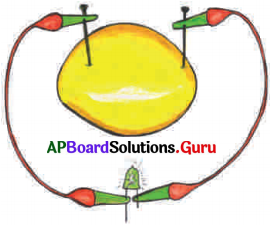
We observe that the bulb will glow as electricity was produced using chemical energy present in the lemon.
Activity – 3
Question 3.
Write an activity two observe the brightness of bulb in the following situations.
1) One cell and one bulb.
2) Two cells in series and one bulb.
3) Two cells in parallel and one bulb.
(OR)
How is the brightness of a bulb when it is connected to a circuit with cells which are connected i) in series and ii) in parallel? Explain with an activity.
Answer:
Situation-1
Material required :
Dry cell -1, Small bulb-1 (torchlight bulb or LED), Switch and Connecting wire.

Procedure:
Take a dry cell, small bulb or LED and a switch. Connect them in a simple circuit using copper wire as shown in given fig. Switch ON and observe the brightness of light. ,
Situation-2 (Cells connected in series) :
Material required :
Dry cells -2, Small bulb-1 (torch light bulb or LED), Switch and Copper wire.
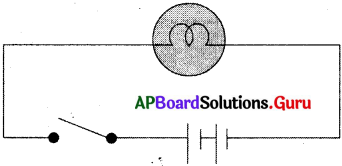
Procedure:
Take two dry cells, small bulb and a switch. Connect them using a copper wire as shown in the fig. Switch ON and observe the brightness of light. Remove one cell and observe the condition of bulb.
Situation-3 (Cells connected in parallel) :
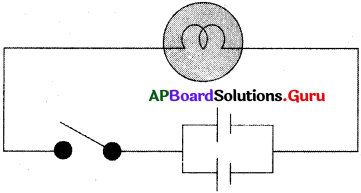
Material required :
Dry cells -2, Small bulb -1 (torch light bulb or LED), Switch and Copper wire.
Procedure:
Take two electric cells small bulb or LED and switch. Connect them using copper wire as shown in fig.
Switch ON and observe the brightness of bulb.Remove one cell and observe the condition of bulb.Record your observations in the above three situations in the given table.

From the table, if a number of cells are connected in series the brightness of the bulb isenhanced. If one of the cells is removed, the circuit becomes open and the bulb will not glow.If a number of cells are connected in parallel the brightness of the bulb remains same. Evenlf one of the cells is removed, the circuit remains same and the bulb will glow as usual.
Activity – 4
Question 4.
Write an activity to show the brightness of the bulbs when two bulbs are connected in series and in parallel.
Answer:
Situation-1
Materials required:
Dry cell -1, Small bulb-1 (torch light bulb or LED), Switch and Connecting wire.
Procedure :
Take a dry cell, small bulb or LED and switch.Connect them in a simple circuit using copper wireas shown fig.. Switch ON and observe the brightness of light.

Situation-2 (Bulbs connected in series):
Materials required:
Electric cell -1, Small bulbs -2 (torch light bulb or LED), Switch and Copper wire.
Procedure :
Take two small bulbs or LED’s, cell and switch.
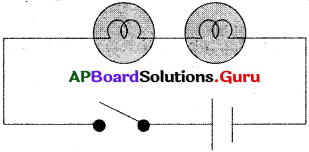
Connect them using copper wire as shown in fig. Switch ON and observe the brightness of the bulbs. Remove one bulb and observe the condition of another bulb.
Situation-3 (Bulbs connected in Parallel):
Materials required:
Electric cell -1, small bulb -2 (torch light), Switch, Copper wire.
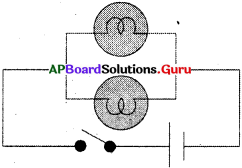
Procedure:
Take two small bulbs, a cell and a switch.Connect them using copper wire as shown in fig. Switch ON and observe the brightness of the bulbs.
Remove one bulb and observe the condition of another bulb.

From the table,if a number of bulbs are connected in series the brightness of the bulb is reduced. If one of the bulbs is removed or broken, the circuit becomes open and the second bulb will not glow. If the number of bulbs are connected in parallel the brightness of the bulb remains same. Even if one of the bulb Is removed or broken, the circuit remains same and the bulb will glow as usual, but the battery drains faster.
Activity – 5
Question 5.
Write an activity to know about beating effect of electric current.
(OR)
What happens if Garment is passed through a Nichrome wire? Explain with an activity.
(OR)
How do von show the heating effect of electricity through an activity?
Answer:
Materials required:
Electric cell, switch. Iron nails-2, wooden board, connecting wires, 10 cm of Nichrome wire.
Procedure :
Construct a circuit using electric cell, switch, connecting wires and iron nails in series connection. Insert the iron nails in the wooden board. Keep the switch in OFF position. Take Nichrome wire and tie it between the iron nails as shown in fig.

Observations :
Now switch ON the circuit for one minute, and switch it OFF. Now, touch the Nichrome wire, (don’t hold Nichrome wire for a long time.) You will observe that the Nichrome wire gets heated up when electricity passed through it. The production of heat due to the flow7 of electricity through a wire is called Heating Effect of Electricity.
![]()
Activity – 6
Question 6.
Write an activity to know about magnetic effect of electric current.
(OR)
How do you make an electromagnet?
(OR)
How do you prepare an electromagnet?
Answer:
Material required:
Battery, Switch Iron nail (nearly 8 cm). Insulated copper wire (50 cm) and small pins.
Procedure:
Take an iron nail and wound the insulated copper wire tightly around the nail. This iron aaS works as a coil. The two ends of the coiled copper wire are connected to a battery and a switch in series connection as shown in fig. (Switch roast be in OFF position. Place some pins near the iron nail and switch ON the circuit.
We observe that, when we switched, on the circuit, all pins ding to the end of the iron nail. This indicates coiled copper wire around nail acts as magnet when electricity passes through it. It means the coiled copper wire around the nail acts as an electromagnet.

When we switched off the circuit, immediately all the pins fall from the iron naS. This indicates that coiled copper wire does not act as a magnet when no electricity7 passes through the circuit
Magnetic effects produced in a coil due to the passing of electricity in the coil is called magnetic effects of electricity.
